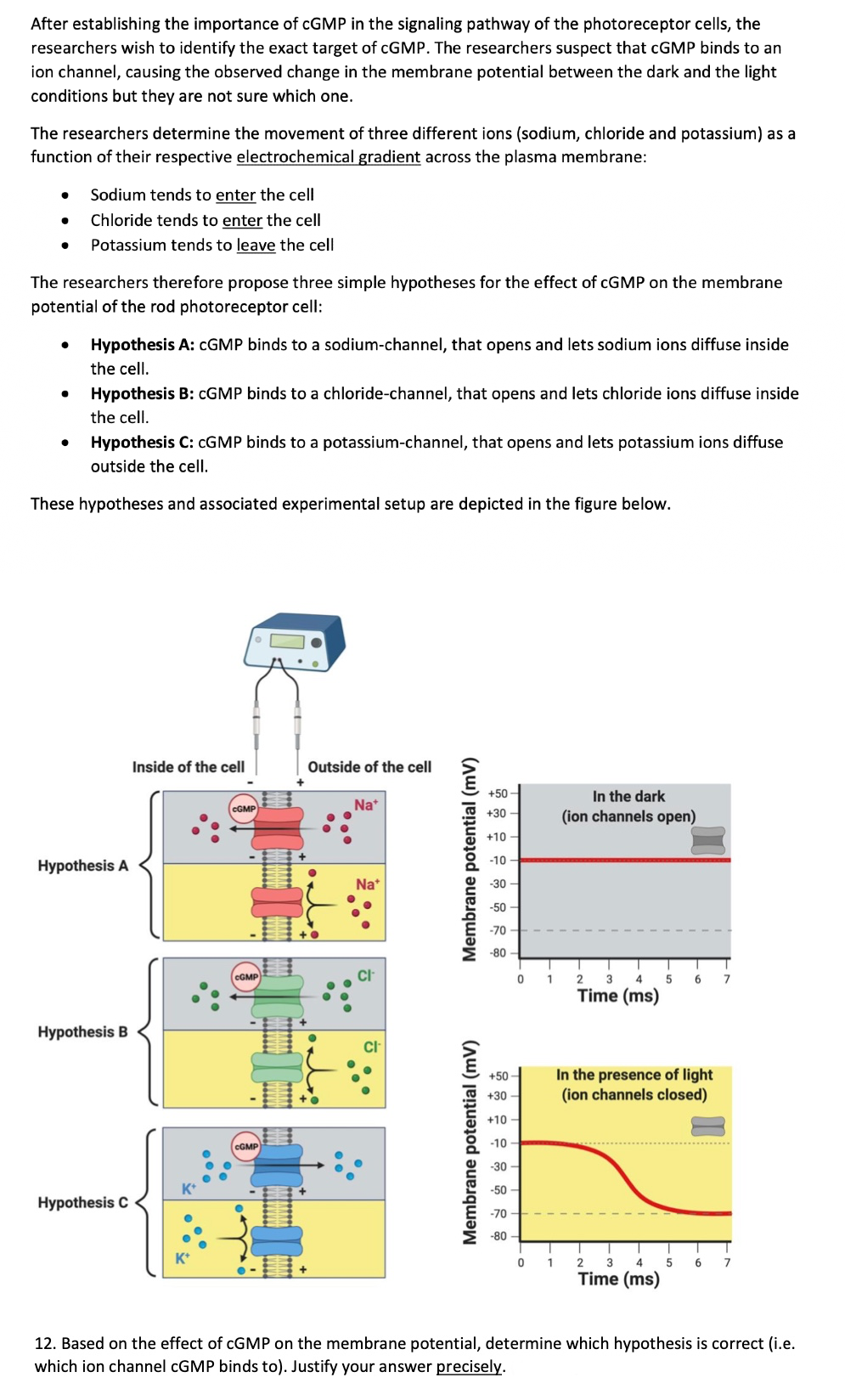ditions but they are not sure which one. researchers determine the movement of three different ions (sodium, chloride and pot ction of their respective electrochemical gradient across the plasma membrane: Sodium tends to enter the cell Chloride tends to enter the cell Potassium tends to leave the cell researchers therefore propose three simple hypotheses for the effect of cGMP on the ential of the rod photoreceptor cell: ● Hypothesis A: cGMP binds to a sodium-channel, that opens and lets sodium ions d the cell. Hypothesis B: CGMP binds to a chloride-channel, that opens and lets chloride ions the cell. Hypothesis C: CGMP binds to a potassium-channel, that opens and lets potassium outside the cell. se hypotheses and associated experimental setup are depicted in the figure below. pothesis A Inside of the cell CGMP Outside of the cell Nat Na mbrane potential (mv) +50- +30 +10- -10 -30- -50- In the dark (ion channels open)
ditions but they are not sure which one. researchers determine the movement of three different ions (sodium, chloride and pot ction of their respective electrochemical gradient across the plasma membrane: Sodium tends to enter the cell Chloride tends to enter the cell Potassium tends to leave the cell researchers therefore propose three simple hypotheses for the effect of cGMP on the ential of the rod photoreceptor cell: ● Hypothesis A: cGMP binds to a sodium-channel, that opens and lets sodium ions d the cell. Hypothesis B: CGMP binds to a chloride-channel, that opens and lets chloride ions the cell. Hypothesis C: CGMP binds to a potassium-channel, that opens and lets potassium outside the cell. se hypotheses and associated experimental setup are depicted in the figure below. pothesis A Inside of the cell CGMP Outside of the cell Nat Na mbrane potential (mv) +50- +30 +10- -10 -30- -50- In the dark (ion channels open)
Human Physiology: From Cells to Systems (MindTap Course List)
9th Edition
ISBN:9781285866932
Author:Lauralee Sherwood
Publisher:Lauralee Sherwood
Chapter4: Principles Of Neural And Hormonal Communication
Section4.5: Intercellular Communication And Signal Transduction
Problem 3CYU: Outline the three general means by which binding of a water soluble extracellular chemical messenger...
Related questions
Question
Please give correct answer

Transcribed Image Text:After establishing the importance of cGMP in the signaling pathway of the photoreceptor cells, the
researchers wish to identify the exact target of cGMP. The researchers suspect that cGMP binds to an
ion channel, causing the observed change in the membrane potential between the dark and the light
conditions but they are not sure which one.
The researchers determine the movement of three different ions (sodium, chloride and potassium) as a
function of their respective electrochemical gradient across the plasma membrane:
●
Sodium tends to enter the cell
Chloride tends to enter the cell
Potassium tends to leave the cell
The researchers therefore propose three simple hypotheses for the effect of cGMP on the membrane
potential of the rod photoreceptor cell:
●
Hypothesis A: CGMP binds to a sodium-channel, that opens and lets sodium ions diffuse inside
the cell.
Hypothesis B: cGMP binds to a chloride-channel, that opens and lets loride ions diffuse inside
the cell.
Hypothesis C: cGMP binds to a potassium-channel, that opens and lets potassium ions diffuse
outside the cell.
These hypotheses and associated experimental setup are depicted in the figure below.
Hypothesis A
Hypothesis B
Hypothesis C
Inside of the cell
CGMP
CGMP
CGMP
Outside of the cell
Na
Na
Membrane potential (mv)
Membrane potential (mv)
+50-
+30-
+10
-10
-30
-50
-70
-80
0 1
+50
+30-
+10
-10
-30-
-50-
-70
-80-
0
1
In the dark
(ion channels open)
T T T
T
2 3 4 5 6 7
Time (ms)
In the presence of light
(ion channels closed)
3 4 5 6 7
2
Time (ms)
12. Based on the effect of cGMP on the membrane potential, determine which hypothesis is correct (i.e.
which ion channel cGMP binds to). Justify your answer precisely.
Expert Solution
This question has been solved!
Explore an expertly crafted, step-by-step solution for a thorough understanding of key concepts.
Step by step
Solved in 3 steps

Recommended textbooks for you

Human Physiology: From Cells to Systems (MindTap …
Biology
ISBN:
9781285866932
Author:
Lauralee Sherwood
Publisher:
Cengage Learning

Human Physiology: From Cells to Systems (MindTap …
Biology
ISBN:
9781285866932
Author:
Lauralee Sherwood
Publisher:
Cengage Learning